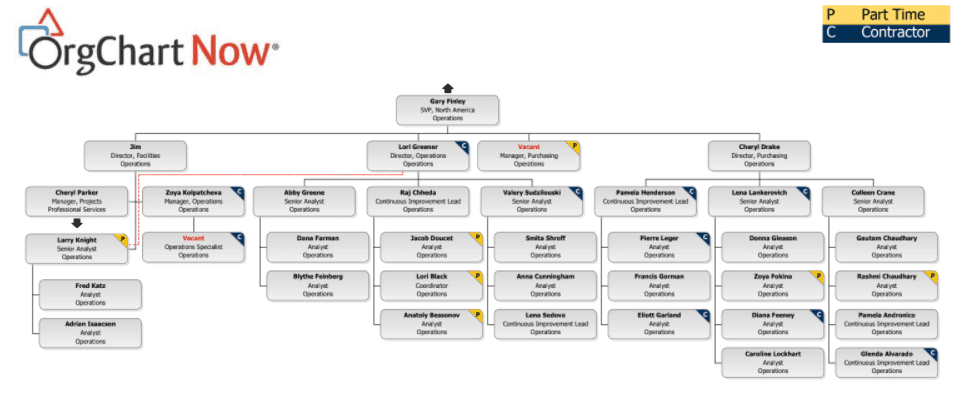June 15, 2023
1:42 PM
By OrgChart Team
Want to bolster your project management strategy and drive success within your organization? In our ever-evolving business landscape, organizational structure is an often-overlooked aspect of project success. To transform your projects internally and externally, leverage the pivotal role organizational structures can play.
With a well-structured organizational chart, or org chart, you establish clarity, streamline communication, manage resources more effectively, and even identify skill‑shortage areas.
Organizational structure is a crucial underpinning of project success in any organization. This blog explores the intricate relationship between organizational structure and project management success, focusing on the HR professional’s role. Ready to learn how org charts can enhance project management success?
Your organizational structure can be a cornerstone of project success. How your company is structured, visually represented by your org charts, sets the stage for how successful projects are managed and executed.
A well-structured organizational chart can foster:
Organizational structures play a vital role in defining the project management environment. The choice of organizational structure can vary, from a purely functional or projectized setup to a hybrid organizational structure, which blends the previous two. Such a hybrid organizational structure offers a platform for a fully functionalized and pure projectized structure to coexist, much like a matrix structure, and is typically used in small and short-duration projects.
This mixed structure shares most of the matrix structure’s benefits, including resource sharing between the parent organization and the projects. However, if a project exceeds its predicted duration, it often tends to transition into a matrix structure, where the project operation intersects with the functional units’ activities.
Regardless of the organizational structure employed, the project’s final stages can often be fraught with tensions and conflicts, similar to the initial step. Resources, time, quality, and scope are reviewed and reported for management decisions, creating a tension‑filled atmosphere.

A well-defined organizational structure plays a crucial role in enhancing communication and collaboration. It simplifies the complex network of interrelationships within your team, making them easily comprehensible and facilitating smoother communication. A clear organizational structure minimizes miscommunication and promotes faster decision-making, allowing your business to adapt rapidly to changing circumstances. As the cornerstone of a collaborative and efficient workforce, a strong organizational structure is especially valuable in remote or hybrid work environments where confusion can easily arise due to lack of in‑person interaction.
Your organizational structure can also serve as a valuable tool for identifying skills gaps and training needs within your organization. By providing a clear understanding of the hierarchy and available skills within the company, it enables HR professionals to pinpoint areas that require additional training or expertise. This proactive approach promotes a culture of continuous learning and professional development, ensuring the organization is always equipped with the right skills for achieving strategic goals. A well-maintained organizational structure acts as a roadmap for continuous improvement, illuminating needed training interventions and preparing your team for future challenges.

Your organizational structure offers a comprehensive overview of your company’s resources, thereby enabling optimal task allocation and workload management. It helps identify team members who are overburdened with tasks and those who have additional capacity. A clear organizational structure aids in implementing an equitable distribution of tasks and responsibilities, reducing the risk of employee burnout and disengagement. By offering an insightful snapshot of your company’s resources, your organizational structure allows leaders to make informed decisions about task delegation and team formation.
Choosing the appropriate project management structure for your organization is critical to project success. Let’s explore different types of organizational structures and how org charts can aid in their implementation:

Matrix structure org chart
In all these structures, org charts can help visualize team relationships and reporting lines, facilitating seamless collaboration and quick responses to industry changes.
Org charts are vital tools that can substantially improve project management success by offering clear hierarchy visualization, enhanced communication, and effective resource management.
Org charts not only foster transparency and accountability in the workplace, but they also aid HR professionals in tracking performance and managing succession planning efficiently. Additionally, organizational charts serve as catalysts for improved communication and collaboration, especially in the era of remote or hybrid work environments. They also enable organizations to identify skills gaps and training needs, promoting a culture of continuous learning and professional development.
By offering a bird’s-eye view of the company’s resources, org charts aid in optimal task allocation and workload management, reducing the risk of employee burnout and disengagement.
Org charts help you structure your organization for better project management, but if your team can’t invest the time it takes to keep them accurate, up to date, and containing all of the right information, it’s hard to justify the time and energy it takes to truly leverage them. OrgChart helps you adapt swiftly to changing circumstances by presenting complex team relationships in a simple format with all of the data you need to confidently speed up your decision-making process. It supports a variety of organizational structures, empowering you to explore alternatives seamlessly based on project scope, duration, skills, gaps, needs, and priorities.
With OrgChart, you can visualize your organization’s structure, provide intelligent HR insights, and instill a culture of accountability. Our software offers an easy-to-understand snapshot of your company, fostering transparency and driving better collaboration, particularly in remote or hybrid work environments.
Choose OrgChart for a robust project management foundation and propel your organization toward unparalleled success.
Transform your project management approach today! Get started with OrgChart. Book a demo now.
Tags: